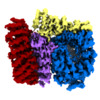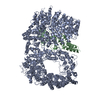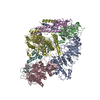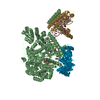+ Open data
Open data
- Basic information
Basic information
| Entry | Database: EMDB / ID: EMD-30912 | |||||||||||||||
|---|---|---|---|---|---|---|---|---|---|---|---|---|---|---|---|---|
| Title | Human 128QHuntingtin-HAP40 complex structure | |||||||||||||||
 Map data Map data | ||||||||||||||||
 Sample Sample |
| |||||||||||||||
 Keywords Keywords | Huntingtin / 128Q / HAP40 / STRUCTURAL PROTEIN | |||||||||||||||
| Function / homology |  Function and homology information Function and homology informationvesicle cytoskeletal trafficking / : / positive regulation of CAMKK-AMPK signaling cascade / microtubule-based transport / vocal learning / negative regulation of proteasomal protein catabolic process / positive regulation of mitophagy / regulation of CAMKK-AMPK signaling cascade / profilin binding / positive regulation of cilium assembly ...vesicle cytoskeletal trafficking / : / positive regulation of CAMKK-AMPK signaling cascade / microtubule-based transport / vocal learning / negative regulation of proteasomal protein catabolic process / positive regulation of mitophagy / regulation of CAMKK-AMPK signaling cascade / profilin binding / positive regulation of cilium assembly / retrograde vesicle-mediated transport, Golgi to endoplasmic reticulum / vesicle transport along microtubule / positive regulation of aggrephagy / positive regulation of lipophagy / Golgi organization / dynein intermediate chain binding / establishment of mitotic spindle orientation / dynactin binding / phosphoprotein phosphatase activity / Regulation of MECP2 expression and activity / postsynaptic cytosol / beta-tubulin binding / presynaptic cytosol / heat shock protein binding / inclusion body / centriole / autophagosome / cytoplasmic vesicle membrane / negative regulation of extrinsic apoptotic signaling pathway / protein destabilization / kinase binding / p53 binding / late endosome / transmembrane transporter binding / early endosome / nuclear body / positive regulation of apoptotic process / axon / apoptotic process / dendrite / perinuclear region of cytoplasm / endoplasmic reticulum / Golgi apparatus / protein-containing complex / nucleoplasm / identical protein binding / nucleus / cytoplasm / cytosol Similarity search - Function | |||||||||||||||
| Biological species |  Homo sapiens (human) Homo sapiens (human) | |||||||||||||||
| Method | single particle reconstruction / cryo EM / Resolution: 4.1 Å | |||||||||||||||
 Authors Authors | Guo Q / Fernandez-Busnadiego R | |||||||||||||||
| Funding support |  Germany, European Union, 4 items Germany, European Union, 4 items
| |||||||||||||||
 Citation Citation |  Journal: Structure / Year: 2021 Journal: Structure / Year: 2021Title: Pathological polyQ expansion does not alter the conformation of the Huntingtin-HAP40 complex. Authors: Bin Huang / Qiang Guo / Marie L Niedermeier / Jingdong Cheng / Tatjana Engler / Melanie Maurer / Alexander Pautsch / Wolfgang Baumeister / Florian Stengel / Stefan Kochanek / Rubén Fernández-Busnadiego /   Abstract: The abnormal amplification of a CAG repeat in the gene coding for huntingtin (HTT) leads to Huntington's disease (HD). At the protein level, this translates into the expansion of a polyglutamine ...The abnormal amplification of a CAG repeat in the gene coding for huntingtin (HTT) leads to Huntington's disease (HD). At the protein level, this translates into the expansion of a polyglutamine (polyQ) stretch located at the HTT N terminus, which renders HTT aggregation prone by unknown mechanisms. Here we investigated the effects of polyQ expansion on HTT in a complex with its stabilizing interaction partner huntingtin-associated protein 40 (HAP40). Surprisingly, our comprehensive biophysical, crosslinking mass spectrometry and cryo-EM experiments revealed no major differences in the conformation of HTT-HAP40 complexes of various polyQ length, including 17QHTT-HAP40 (wild type), 46QHTT-HAP40 (typical polyQ length in HD patients), and 128QHTT-HAP40 (extreme polyQ length). Thus, HTT polyQ expansion does not alter the global conformation of HTT when associated with HAP40. | |||||||||||||||
| History |
|
- Structure visualization
Structure visualization
| Movie |
 Movie viewer Movie viewer |
|---|---|
| Structure viewer | EM map:  SurfView SurfView Molmil Molmil Jmol/JSmol Jmol/JSmol |
| Supplemental images |
- Downloads & links
Downloads & links
-EMDB archive
| Map data |  emd_30912.map.gz emd_30912.map.gz | 10.6 MB |  EMDB map data format EMDB map data format | |
|---|---|---|---|---|
| Header (meta data) |  emd-30912-v30.xml emd-30912-v30.xml emd-30912.xml emd-30912.xml | 15.2 KB 15.2 KB | Display Display |  EMDB header EMDB header |
| Images |  emd_30912.png emd_30912.png | 169.5 KB | ||
| Filedesc metadata |  emd-30912.cif.gz emd-30912.cif.gz | 7.4 KB | ||
| Archive directory |  http://ftp.pdbj.org/pub/emdb/structures/EMD-30912 http://ftp.pdbj.org/pub/emdb/structures/EMD-30912 ftp://ftp.pdbj.org/pub/emdb/structures/EMD-30912 ftp://ftp.pdbj.org/pub/emdb/structures/EMD-30912 | HTTPS FTP |
-Validation report
| Summary document |  emd_30912_validation.pdf.gz emd_30912_validation.pdf.gz | 453.3 KB | Display |  EMDB validaton report EMDB validaton report |
|---|---|---|---|---|
| Full document |  emd_30912_full_validation.pdf.gz emd_30912_full_validation.pdf.gz | 452.9 KB | Display | |
| Data in XML |  emd_30912_validation.xml.gz emd_30912_validation.xml.gz | 5.4 KB | Display | |
| Data in CIF |  emd_30912_validation.cif.gz emd_30912_validation.cif.gz | 6.1 KB | Display | |
| Arichive directory |  https://ftp.pdbj.org/pub/emdb/validation_reports/EMD-30912 https://ftp.pdbj.org/pub/emdb/validation_reports/EMD-30912 ftp://ftp.pdbj.org/pub/emdb/validation_reports/EMD-30912 ftp://ftp.pdbj.org/pub/emdb/validation_reports/EMD-30912 | HTTPS FTP |
-Related structure data
| Related structure data |  7dxkMC  7dxjC M: atomic model generated by this map C: citing same article ( |
|---|---|
| Similar structure data |
- Links
Links
| EMDB pages |  EMDB (EBI/PDBe) / EMDB (EBI/PDBe) /  EMDataResource EMDataResource |
|---|---|
| Related items in Molecule of the Month |
- Map
Map
| File |  Download / File: emd_30912.map.gz / Format: CCP4 / Size: 15.6 MB / Type: IMAGE STORED AS FLOATING POINT NUMBER (4 BYTES) Download / File: emd_30912.map.gz / Format: CCP4 / Size: 15.6 MB / Type: IMAGE STORED AS FLOATING POINT NUMBER (4 BYTES) | ||||||||||||||||||||||||||||||||||||||||||||||||||||||||||||||||||||
|---|---|---|---|---|---|---|---|---|---|---|---|---|---|---|---|---|---|---|---|---|---|---|---|---|---|---|---|---|---|---|---|---|---|---|---|---|---|---|---|---|---|---|---|---|---|---|---|---|---|---|---|---|---|---|---|---|---|---|---|---|---|---|---|---|---|---|---|---|---|
| Projections & slices | Image control
Images are generated by Spider. | ||||||||||||||||||||||||||||||||||||||||||||||||||||||||||||||||||||
| Voxel size | X=Y=Z: 1.35 Å | ||||||||||||||||||||||||||||||||||||||||||||||||||||||||||||||||||||
| Density |
| ||||||||||||||||||||||||||||||||||||||||||||||||||||||||||||||||||||
| Symmetry | Space group: 1 | ||||||||||||||||||||||||||||||||||||||||||||||||||||||||||||||||||||
| Details | EMDB XML:
CCP4 map header:
| ||||||||||||||||||||||||||||||||||||||||||||||||||||||||||||||||||||
-Supplemental data
- Sample components
Sample components
-Entire : Human 128QHuntingtin-HAP40 complex structure
| Entire | Name: Human 128QHuntingtin-HAP40 complex structure |
|---|---|
| Components |
|
-Supramolecule #1: Human 128QHuntingtin-HAP40 complex structure
| Supramolecule | Name: Human 128QHuntingtin-HAP40 complex structure / type: complex / ID: 1 / Parent: 0 / Macromolecule list: all |
|---|---|
| Source (natural) | Organism:  Homo sapiens (human) Homo sapiens (human) |
-Macromolecule #1: Huntingtin
| Macromolecule | Name: Huntingtin / type: protein_or_peptide / ID: 1 / Details: 128Q-Huntingtin / Number of copies: 1 / Enantiomer: LEVO |
|---|---|
| Source (natural) | Organism:  Homo sapiens (human) Homo sapiens (human) |
| Molecular weight | Theoretical: 361.698406 KDa |
| Recombinant expression | Organism:  |
| Sequence | String: MATLEKLMKA FESLKSFQQQ QQQQQQQQQQ QQQQQQQQQQ QQQQQQQQQQ QQQQQQQQQQ QQQQQQQQQQ QQQQQQQQQQ QQQQQQQQQ QQQQQQQQQQ QQQQQQQQQQ QQQQQQQQQQ QQQQQQQQQQ QQQQQQQQQQ QQQQQQPPPP PPPPPPPQLP Q PPPQAQPL ...String: MATLEKLMKA FESLKSFQQQ QQQQQQQQQQ QQQQQQQQQQ QQQQQQQQQQ QQQQQQQQQQ QQQQQQQQQQ QQQQQQQQQQ QQQQQQQQQ QQQQQQQQQQ QQQQQQQQQQ QQQQQQQQQQ QQQQQQQQQQ QQQQQQQQQQ QQQQQQPPPP PPPPPPPQLP Q PPPQAQPL LPQPQPPPPP PPPPPGPAVA EEPLHRPKKE LSATKKDRVN HCLTICENIV AQSVRNSPEF QKLLGIAMEL FL LCSDDAE SDVRMVADEC LNKVIKALMD SNLPRLQLEL YKEIKKNGAP RSLRAALWRF AELAHLVRPQ KCRPYLVNLL PCL TRTSKR PEESVQETLA AAVPKIMASF GNFANDNEIK VLLKAFIANL KSSSPTIRRT AAGSAVSICQ HSRRTQYFYS WLLN VLLGL LVPVEDEHST LLILGVLLTL RYLVPLLQQQ VKDTSLKGSF GVTRKEMEVS PSAEQLVQVY ELTLHHTQHQ DHNVV TGAL ELLQQLFRTP PPELLQTLTA VGGIGQLTAA KEESGGRSRS GSIVELIAGG GSSCSPVLSR KQKGKVLLGE EEALED DSE SRSDVSSSAL TASVKDEISG ELAASSGVST PGSAGHDIIT EQPRSQHTLQ ADSVDLASCD LTSSATDGDE EDILSHS SS QVSAVPSDPA MDLNDGTQAS SPISDSSQTT TEGPDSAVTP SDSSEIVLDG TDNQYLGLQI GQPQDEDEEA TGILPDEA S EAFRNSSMAL QQAHLLKNMS HCRQPSDSSV DKFVLRDEAT EPGDQENKPC RIKGDIGQST DDDSAPLVHC VRLLSASFL LTGGKNVLVP DRDVRVSVKA LALSCVGAAV ALHPESFFSK LYKVPLDTTE YPEEQYVSDI LNYIDHGDPQ VRGATAILCG TLICSILSR SRFHVGDWMG TIRTLTGNTF SLADCIPLLR KTLKDESSVT CKLACTAVRN CVMSLCSSSY SELGLQLIID V LTLRNSSY WLVRTELLET LAEIDFRLVS FLEAKAENLH RGAHHYTGLL KLQERVLNNV VIHLLGDEDP RVRHVAAASL IR LVPKLFY KCDQGQADPV VAVARDQSSV YLKLLMHETQ PPSHFSVSTI TRIYRGYNLL PSITDVTMEN NLSRVIAAVS HEL ITSTTR ALTFGCCEAL CLLSTAFPVC IWSLGWHCGV PPLSASDESR KSCTVGMATM ILTLLSSAWF PLDLSAHQDA LILA GNLLA ASAPKSLRSS WASEEEANPA ATKQEEVWPA LGDRALVPMV EQLFSHLLKV INICAHVLDD VAPGPAIKAA LPSLT NPPS LSPIRRKGKE KEPGEQASVP LSPKKGSEAS AASRQSDTSG PVTTSKSSSL GSFYHLPSYL RLHDVLKATH ANYKVT LDL QNSTEKFGGF LRSALDVLSQ ILELATLQDI GKCVEEILGY LKSCFSREPM MATVCVQQLL KTLFGTNLAS QFDGLSS NP SKSQGRAQRL GSSSVRPGLY HYCFMAPYTH FTQALADASL RNMVQAEQEN DTSGWFDVLQ KVSTQLKTNL TSVTKNRA D KNAIHNHIRL FEPLVIKALK QYTTTTCVQL QKQVLDLLAQ LVQLRVNYCL LDSDQVFIGF VLKQFEYIEV GQFRESEAI IPNIFFFLVL LSYERYHSKQ IIGIPKIIQL CDGIMASGRK AVTHAIPALQ PIVHDLFVLR GTNKADAGKE LETQKEVVVS MLLRLIQYH QVLEMFILVL QQCHKENEDK WKRLSRQIAD IILPMLAKQQ MHIDSHEALG VLNTLFEILA PSSLRPVDML L RSMFVTPN TMASVSTVQL WISGILAILR VLISQSTEDI VLSRIQELSF SPYLISCTVI NRLRDGDSNS TLEEHSEGKQ IK NLPEETF SRFLLQLVGI LLEDIVTKQL KVEMSEQQHT FYCQELGTLL MCLIHIFKSG MFRRITAAAT RLFRSDGCGG SFY TLDSLN LRARSMITTH PALVLLWCQI LLLVNHTDYR WWAEVQQTPK RHSLSSTKLL SPQMSGEEED SDLAAKLGMC NREI VRRGA LILFCDYVCQ NLHDSEHLTW LIVNHIQDLI SLSHEPPVQD FISAVHRNSA ASGLFIQAIQ SRCENLSTPT MLKKT LQCL EGIHLSQSGA VLTLYVDRLL CTPFRVLARM VDILACRRVE MLLAANLQSS MAQLPMEELN RIQEYLQSSG LAQRHQ RLY SLLDRFRLST MQDSLSPSPP VSSHPLDGDG HVSLETVSPD KDWYVHLVKS QCWTRSDSAL LEGAELVNRI PAEDMNA FM MNSEFNLSLL APCLSLGMSE ISGGQKSALF EAAREVTLAR VSGTVQQLPA VHHVFQPELP AEPAAYWSKL NDLFGDAA L YQSLPTLARA LAQYLVVVSK LPSHLHLPPE KEKDIVKFVV ATLEALSWHL IHEQIPLSLD LQAGLDCCCL ALQLPGLWS VVSSTEFVTH ACSLIHCVHF ILEAVAVQPG EQLLSPERRT NTPKAISEEE EEVDPNTQNP KYITAACEMV AEMVESLQSV LALGHKRNS GVPAFLTPLL RNIIISLARL PLVNSYTRVP PLVWKLGWSP KPGGDFGTAF PEIPVEFLQE KEVFKEFIYR I NTLGWTSR TQFEETWATL LGVLVTQPLV MEQEESPPEE DTERTQINVL AVQAITSLVL SAMTVPVAGN PAVSCLEQQP RN KPLKALD TRFGRKLSII RGIVEQEIQA MVSKRENIAT HHLYQAWDPV PSLSPATTGA LISHEKLLLQ INPERELGSM SYK LGQVSI HSVWLGNSIT PLREEEWDEE EEEEADAPAP SSPPTSPVNS RKHRAGVDIH SCSQFLLELY SRWILPSSSA RRTP AILIS EVVRSLLVVS DLFTERNQFE LMYVTLTELR RVHPSEDEIL AQYLVPATCK AAAVLGMDKA VAEPVSRLLE STLRS SHLP SRVGALHGVL YVLECDLLDD TAKQLIPVIS DYLLSNLKGI AHCVNIHSQQ HVLVMCATAF YLIENYPLDV GPEFSA SII QMCGVMLSGS EESTPSIIYH CALRGLERLL LSEQLSRLDA ESLVKLSVDR VNVHSPHRAM AALGLMLTCM YTGKEKV SP GRTSDPNPAA PDSESVIVAM ERVSVLFDRI RKGFPCEARV VARILPQFLD DFFPPQDIMN KVIGEFLSNQ QPYPQFMA T VVYKVFQTLH STGQSSMVRD WVMLSLSNFT QRAPVAMATW SLSCFFVSAS TSPWVAAILP HVISRMGKLE QVDVNLFCL VATDFYRHQI EEELDRRAFQ SVLEVVAAPG SPYHRLLTCL RNVHKVTTC UniProtKB: Huntingtin, Huntingtin |
-Macromolecule #2: 40-kDa huntingtin-associated protein
| Macromolecule | Name: 40-kDa huntingtin-associated protein / type: protein_or_peptide / ID: 2 / Number of copies: 1 / Enantiomer: LEVO |
|---|---|
| Source (natural) | Organism:  Homo sapiens (human) Homo sapiens (human) |
| Molecular weight | Theoretical: 39.141879 KDa |
| Recombinant expression | Organism:  |
| Sequence | String: MAAAAAGLGG GGAGPGPEAG DFLARYRLVS NKLKKRFLRK PNVAEAGEQF GQLGRELRAQ ECLPYAAWCQ LAVARCQQAL FHGPGEALA LTEAARLFLR QERDARQRLV CPAAYGEPLQ AAASALGAAV RLHLELGQPA AAAALCLELA AALRDLGQPA A AAGHFQRA ...String: MAAAAAGLGG GGAGPGPEAG DFLARYRLVS NKLKKRFLRK PNVAEAGEQF GQLGRELRAQ ECLPYAAWCQ LAVARCQQAL FHGPGEALA LTEAARLFLR QERDARQRLV CPAAYGEPLQ AAASALGAAV RLHLELGQPA AAAALCLELA AALRDLGQPA A AAGHFQRA AQLQLPQLPL AALQALGEAA SCQLLARDYT GALAVFTRMQ RLAREHGSHP VQSLPPPPPP APQPGPGATP AL PAALLPP NSGSAAPSPA ALGAFSDVLV RCEVSRVLLL LLLQPPPAKL LPEHAQTLEK YSWEAFDSHG QESSGQLPEE LFL LLQSLV MATHEKDTEA IKSLQVEMWP LLTAEQNHLL HLVLQETISP SGQGV UniProtKB: 40-kDa huntingtin-associated protein |
-Experimental details
-Structure determination
| Method | cryo EM |
|---|---|
 Processing Processing | single particle reconstruction |
| Aggregation state | particle |
- Sample preparation
Sample preparation
| Buffer | pH: 7 |
|---|---|
| Grid | Model: Quantifoil / Material: GOLD / Support film - Material: GRAPHENE / Support film - topology: CONTINUOUS |
| Vitrification | Cryogen name: ETHANE-PROPANE |
- Electron microscopy
Electron microscopy
| Microscope | FEI TITAN KRIOS |
|---|---|
| Image recording | Film or detector model: GATAN K2 SUMMIT (4k x 4k) / Average electron dose: 60.0 e/Å2 |
| Electron beam | Acceleration voltage: 300 kV / Electron source:  FIELD EMISSION GUN FIELD EMISSION GUN |
| Electron optics | Illumination mode: FLOOD BEAM / Imaging mode: BRIGHT FIELD |
| Experimental equipment |  Model: Titan Krios / Image courtesy: FEI Company |
- Image processing
Image processing
| Startup model | Type of model: EMDB MAP |
|---|---|
| Final reconstruction | Resolution.type: BY AUTHOR / Resolution: 4.1 Å / Resolution method: FSC 0.143 CUT-OFF / Number images used: 122992 |
| Initial angle assignment | Type: PROJECTION MATCHING / Software - Name: RELION |
| Final angle assignment | Type: PROJECTION MATCHING / Software - Name: RELION |
 Movie
Movie Controller
Controller

















 Z (Sec.)
Z (Sec.) Y (Row.)
Y (Row.) X (Col.)
X (Col.)





















